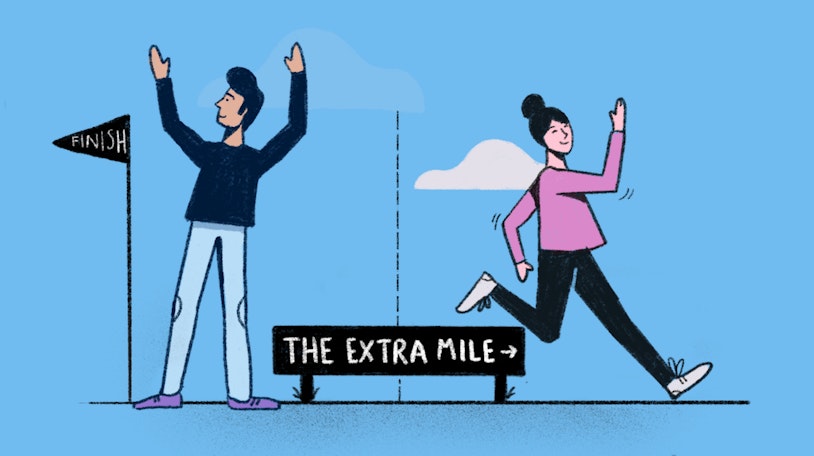Nowadays, everyone is talking about their customer success teams. Customer success has become synonymous with customer loyalty and excellent customer experience, so it's no surprise it's a hot topic.
That said, plenty of companies don't yet have a customer success team or even know what a customer success strategy would look like for them.
In this post, we'll break down the logistics of what your customer success team should look like, what the key hires will be responsible for, and how to navigate customer success if you can't hire staff for an entirely focused team.
An introduction to customer success
Customer success is an engagement strategy where companies work with customers to understand their needs and then proactively address those needs. It helps to lower churn and boost key metrics like customer loyalty, retention, and renewal rates.
While the discipline of customer success feels new, it's been around for 25 years. It came about in 1996 at a company called Vantive. The CEO of Vantive uncovered an individual, Marie Alexander, who was using their CRM software in uniquely customer-focused ways, then hired her to create their first customer success team.
Alexander came on board and built a services team specifically focused on providing value and success to their customers. It was the first team called "customer success," and an industry was born.
How is customer success different from support?
While this is undoubtedly changing as customer experience expands, customer support teams have traditionally handled reactive responses to customer issues.
Customer success teams, however, are responsible for proactively addressing customer needs: Doing deeper dives into what customers want and expect from a product and helping them reach their goals rather than answering inquiries as they come up.
Rather than replace support, customer success teams work in tandem with support to create the best possible customer experience.
When to start your customer success team
It might feel compelling to start your customer success team right from your company's start like you would with support. But, unlike support, you probably don't need a customer success team from the get-go.
The truth of the matter is that you can probably hold off on starting a customer success team until you have a few customers and a bit more data about what they care about.
A good rule of thumb is to wait until you have higher-value clients who can take advantage of your customer success team's work. For instance, if 80% of your customers make up 20% of your revenue, it's time to build your customer success function.
Start by hiring a leader, someone who has already worked in customer success and has experience building a structure and processes. Then, after they've had a chance to uncover your customer needs and start building out the skeleton of a successful team, it's time to start hiring customer success managers (CSMs).
What is a customer success team responsible for?
Your CS team is like a swiss army knife — there are very few customer-related things that they are not involved in. Here are some of the key responsibilities of a fully built-out customer success team:
Customer success management: Customer success management is the typical work associated with CSMs: building relationships, helping to boost retention, and managing churn. Much of this work is positioning your team as a strategic partner with your customers through regular meetings, quarterly business reviews (QBRs), and scheduled emails.
Onboarding: Some refer to onboarding as enablement or implementation. Your customer success team will help to onboard your new customers, both one-on-one and at scale.
Providing support: Occasionally, your customer success team will need to support the clients they are managing. While most of the reactive inquiries will still fall to your support team, you should sometimes expect them to answer questions that would otherwise go to the inbox.
Customer training and proactive education: This is especially relevant for customer success teams in companies that haven't formalized proactive education and training. Proactive education could be anything from webinars and email campaigns to writing documentation and creating ongoing education certifications.
Professional services: Some companies refer to this function as consulting or services. Suppose there are tangential needs, such as design, coding, or another uncommon specialized skill, that your customers may need to succeed with your product. In that case, you can offer professional services at an additional cost and have someone on your team help your customers find success.
Renewals: When the time comes for your customers to renew their contracts with you, your customer success team will be responsible for guiding them through the process and securing their renewal.
Upsells: Your customer success team should continually evaluate your customers' needs and how your other product offerings can fit them. Then, they'll use those opportunities to position new solutions and upsells appropriately.
Pre-sales: Your customer success team should expect to get involved in the pre-sales cycle with your sales team. When they can get involved before the customer makes a purchase, it makes the handover and transition to customer success much more comfortable for your customers.
Sharing customer insights: Your customer success team knows your customers better than almost anyone. You should encourage them to share those insights with the rest of your company. Use them to develop a deeper understanding of your product feature set and your customers’ needs, and help your marketing team cater their content to things that your users care about.
When you list it out like that, it looks like a lot! Your customer success team is responsible for much of the customer journey, and it takes a few different types of people to make the team run smoothly. Next, we'll look at the roles that you can expect to hire for your customer success team.
Common customer success team roles
Like any other team within a company, several different roles make a customer success team function. We'll start at the very top:
Chief Customer Officer
This person likely doesn't just have oversight over customer success, but perhaps over all the customer-facing functions within a company.
The CCO will collaborate directly with the rest of the c-level executives to ensure that the customer experience team’s concerns are addressed and considered at the highest level. They are also responsible for planning the multi-year strategy of the customer-facing groups.
Vice President of Customer Success
The VP of CS reports up to the CCO. They are responsible for the customer success functionality at the company, rather than the overarching customer experience. The VP of CS can expect to handle things like:
Creating a customer journey map.
Designing a touchpoints process and framework for the customer success team.
Devising measurements for success across the CS team.
Managing the success of customer success initiatives, like onboarding and QBRs.
Determining the multi-year strategy of the customer success team in partnership with the CCO.
Manager/Team Lead of Customer Success
This individual is responsible for managing the day-to-day of the customer success team. They work with the VP of CS to understand the group's goals and needs and then coach and train the CSMs and Implementation Managers toward victory.
They also work closely with the leads or managers of other teams, like sales and product, to ensure that they meet company goals at a team-wide level.
Customer Success Managers (CSMs)
CSMs are responsible for the success of the customers. They manage/create daily activities to connect and train customers in best practices, onboard them when they are just getting started, and ensure their success when it comes to renewal time.
CSMs are the backbone of the customer success team. A team will probably have more CSMs than any other role.
Implementation Manager
Some companies choose to have a specialized role in specifically assisting with onboarding customers. This structure is beneficial if the product's installation or implementation is technical or more complicated than usual.
An implementation manager is responsible for working with the sales and customer success team to ensure that the customer's onboarding and implementation experience is smooth and painless. They serve as a single point of contact across the start of a customer's experience.
Skills to hire for in your customer success team
No matter which role you are hiring for, most customer success team members will have a few similar skills and competencies. Here are a few things to look for when reviewing resumes and starting to hire for your team:
Ability to create KPIs and metrics that make sense and incentivize customer-centric behavior.
Willingness to conduct meetings (like QBRs) and comfort working with customers at any level, including large enterprise ones.
Adaptability: Customer success team members need to be able to roll with the punches.
Knowledge of customer success-specific software and tooling — essential if starting a team from scratch. The contextual experience will be helpful.
The drive to listen to and seek to understand different perspectives.
Hunger for success: Anyone who sees longevity in a customer success role needs to have an internal drive and a strong competitive desire to succeed.
Level-headedness: Customer success team members need to stay calm under pressure.
Your customers will not always be easy to please, and the path to success will not always be straightforward. Hiring individuals with these traits will help make things easier and make the process more enjoyable for your customers and team members alike.
How to prioritize customer success without a team
It might not be in the cards for you to build a customer success team in some cases. Perhaps you lack the budget or the structure or even just the customers needed to necessitate a full team.
There are still ways for your company to prioritize your customers' success, even without building a fully-scaled CS team. Here are a few things that can be automated or scaled by other functions outside of customer success.
Proactive support and onboarding
While your proactive support functionality will be more robust with a team's dedicated focus, members of your support or marketing teams can work to get it off the ground.
Start by creating automated onboarding functionality by using a tool like Appcues or via a triggered email campaign. Use software like Help Scout Beacon to surface documentation to your customers before they create support requests.
Proactively helping your customers before they reach out with inquiries guides them toward success without a dedicated CSM.
Tiered support offerings
Your support team can start to fill in the gaps that a customer success team typically would. If you begin to determine appropriate tiers and offerings in support, it can help your higher value customers feel like you are caring for them in the way they'd like.
For instance, perhaps companies on your business and enterprise plans receive phone support, while those on a starter plan only receive email support. Offering higher value services on more expensive plans helps to pave the way for an easy transition to a customer success team.
Creating a customer journey map
If you don't already have a customer journey map, it's a vital step in the right direction to understanding your customers' success. You do not need a customer success team to own this initiative, either. It can be cross-functional amongst your support, sales, product, and marketing teams.
Work to understand each of the touchpoints in the customer journey, and use surveys like CSAT, NPS, and CES to track your customers' sentiments through each of them.
A customer journey map will help your cross-functional teams understand where your customer experience needs to improve and where the most significant opportunities to create customer success are.
Your ideal customer success team awaits
Whether customer success looks like a fully-stacked customer success team or just investing in some individual strategies, there's no doubt that it's valuable for your customer experience.
Start by understanding what customer success looks like to your company. Are you at a place where a customer success team would add value, or would it just distract from your company's work in customer experience?
From there, identify what your team's structure will look like and what key hires you need to make. Base this off of the needs that you have for your customer success strategy.
It's valuable to start with an experienced leader, but after that, your team's composition depends on what you need most for your customers. Be sure to identify the critical competencies for the type of unit you're hiring for before embarking upon the interview process. The wrong hire can make or break a small team or a young strategy.
If it's not the right time for you to build your customer success team, there are still opportunities to promote customer success within your customer base. Work to build out your proactive support and onboarding structures, create tiered support offerings, and develop a customer journey map.
All of these things will set you up for success, with or without a dedicated team to enact them.








